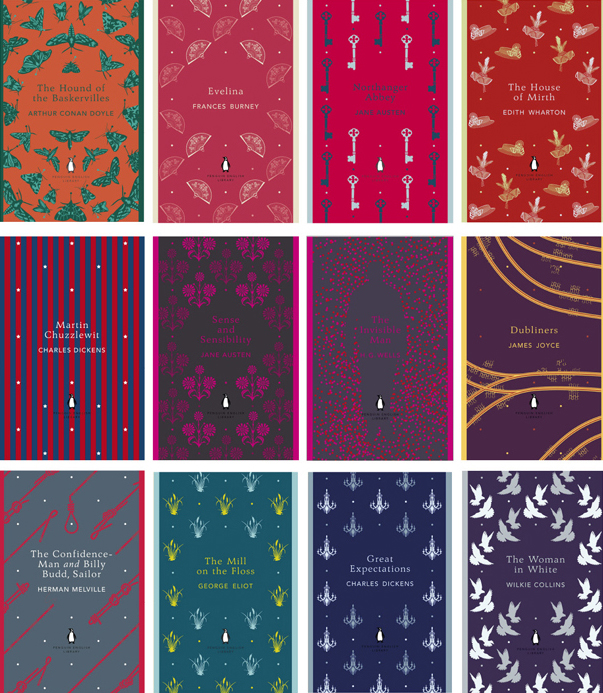
The Penguin English Library comprises a hundred of the best-loved English Language classics of pre-WWI literature. With a handsome series design by Coralie Bickford-Smith – also responsible for designing Penguin’s hardback reissues of F. Scott Fitzgerald, with their gorgeous foil-stamped deco jackets – the new Penguins use symbols and motifs from the texts to illustrate their contents.
There’s a very contemporary feel to these covers – something like Timorous Beasties textile meets desktop icon. The colourful vertical banding and consistent use of Penguin’s signature orange colour makes them stand out on the shelf, while the maximum four-colour palette and neat grid template hints at a modern take on Jan Tschichold and Hans Moller’s instantly recognisable minimalist “banded” design for Penguin Classics of the 1950s.
These covers are rather livelier, however. Jaunty sticks of TNT ricochet around the cover of Chesterton’s surreal spy adventure The Man Who Was Thursday; lip-prints smack the cover of Fielding’s ribald Tom Jones; and Richardson’s Clarissa, a sort of handbook of 18th century morality masquerading as a novel, is decorated with elaborate locks and keys to signify the instructive chastity of its eponymous heroine. Some of the illustrations can be a little obscure – we doubt the first thing that leaps to Alice in Wonderland readers’ minds is the croquet game in which flamingos act as stumps, nor are roosters the obvious symbol for Tess of the d’Urbervilles – but that’s part of the fun of these editions.
And – because another pleasure of a series with a strict cover format emerges when that rigid format is dispensed or played around with – we especially love those covers where the underlying diamond-patterned grid has been distorted for a more elaborate illustration: the Escher-esque unending stairwells of Bleak House, the gothic lightning strike for Charlotte Brontë’s Villette, an unfettered jungle scene that’s slowly overgrowing the blank spaces on Robinson Crusoe.
Unlike some reprints, the Penguin English Library uses reset texts (so the typeface is clean and modern). Appended to each book is a short essay or other bit of “bonus material”: an afterword by Harold Bloom to Tobias Smollett’s Humphry Clinker, or, most pleasingly, for Frances (formerly Fanny, until weird 21st-century prudery redacted the abbreviation) Burney’s Evelina, some pages from the author’s journal which describe the publication of her book, and her worries about the reaction when her nearest and dearest read it. Evelina was published in 1778 – and Burney was among the very first women to write what we’d recognise as a novel, even if she had to publish it anonymously – but across the centuries, in these handsome new editions, these books speak to us in contemporary voices.


